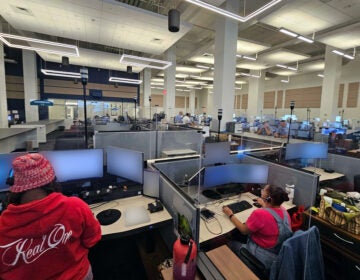Veils from across the globe on display at East Falls exhibit
Material Culture partner Isabella de la Houssaye said that assembling her collection of 19th, 20th and 21st-century veils from around the world was the easy part. It was much harder to research the elusive cultures that seem so mysterious to the western eye.
She started collecting veils in 2001 when she and her family were traveling in Egypt. The collection now spans the silver-laden garments of Sudan’s Rashaida people, Palestinian Bedouin thobes, an Indian wedding dupatta, colorful paranjas of Uzbekistan and many more.
But being able to purchase the veils wasn’t the same as understanding them — or being able to explain them to the public.
On the trail of the veils
“The veils, for the most part, are coming from nomadic cultures, and there’s just not a lot of research that’s easy to find,” de la Houssaye said, chatting with NewsWorks as her Veil Code exhibition got underway in East Falls recently.
Later, giving a tour of the gallery at the international auction and retail house, de la Houssaye added that since most of the veils are worn by women, it’s even harder to learn about them in male-dominated cultures.
However, she did notice that many of the male shopkeepers who sold the veils to her over the years respected their artistry and significance.
In many cases, the tinkling cascades of silver coins on some veils would have been worth a lot more when removed from the garment, but sellers kept the clothing intact.
Look and listen
The exhibition boasts of coin-covered veils from several cultures — sometimes part of a special dowry, or bride price, that a woman would wear on her clothing for life. These include Ottoman, Palestinian and Egyptian coins.
A display of Bedouin head-pieces includes eighteenth-century Maria Theresa Thalers, a currency of the Austrian empire that gained wide popularity in the Middle East.
“They say no two veils sound alike,” de la Houssaye explained of the veils’ unique auditory qualities. In some cultures, an array of coins, beads, tassels and shells, made differently by each woman, would mean that one could identify a person just by the sound of her garments.
Hiding or broadcasting?
The importance of that individuality is part of what de la Houssaye hopes visitors will take away from the exhibit, in a world where veils have become a politically charged topic.
“Textiles historically communicate a lot of about a person,” she said.
In western culture today, many people assume veils are a tool of oppression or a way to hide women’s identity, when “really in that historical context, they were broadcasting their identity,” she noted.
Across many cultures, custom-made veils could signify tribal, family and regional roots, marital status, age, wealth or other identifying factors through structure, fabric, color, embroidery and accessories.
The latter often had special protective or religious meanings, like prosperity or fertility.
There’s no one way to think about veils in terms of “women’s liberation,” de la Houssaye insisted. “When you wear these pieces, you’re really saying, ‘This is who I am.'”
Her research also gives gallery visitors a window into history.
For example, early 20th century Russian imperialism in central Asia helped to make the role of the veil an ongoing tug-of-war across the world.
Following the industrialization of the Russian invasion, women used the garments to reassert their personal roots.
Then, the pendulum swung the other way, making veils compulsory in some cultures. But for the women involved, “what you really want is the right to choose,” she said.
Gender nonspecific (in this case)
Another highlight of the exhibition is a veil from the only known culture that covers its men, and not its women.
Tuareg men, members of a nomadic Berber tribe of Tunisia, Libya and Mali, cover their head and mouth with an indigo veil called a tagelmust more than 10 meters long.
Because of their desert home, the Taureg rely on a dry-dyeing process for their signature garment, and over time, the tagelmust’s indigo color affects the wearer’s skin.
That’s why these Berber men are sometimes called “the blue men of the desert.”
From Louisiana to North Korea
De la Houssaye, a dedicated runner, remembers passing Tuareg tribesmen on a long-distance race across Libya several years ago.
Along with her Serbian husband and five children, she has traveled the world with a career in international law and banking.
She said her first big cultural jump was going from her roots in a Cajun Louisiana farming community to college at Princeton. She’s never stopped moving.
Last August, she and the kids traveled to North Korea.
“My youngest is 12, and he’s been to more than 60 countries,” she said of her family’s international lifestyle.
Two other children are fluent in Arabic; one learned while working at a peace non-profit in Israel, and the other, a daughter finishing high school, plans to travel to Palestine this summer.
She said another son is biking from Cairo to Capetown on a conservation mission.
De la Houssaye originally imagined mounting her veils exhibit in the controversial post-9/11 Muslim community center that was proposed near Ground Zero.
She herself lost her office building in the World Trade Center attacks, but decided to respond by taking the family to Egypt that Christmas.
“We’re trying to create bridges to other cultures,” she said.
Exhibit details
“The Veil Code Exhibition,” Isabella de la Houssaye’s private collection of veils and traditional dress from Asia, Africa and the Middle East” is on display in Material Culture’s mezzanine gallery, 4701 Wissahickon Ave., until Dec. 29.
De la Houssaye will offer an hour-long gallery talk at 11 a.m. on Dec. 3.
Gallery tours are available by appointment at (215) 849-8030.
WHYY is your source for fact-based, in-depth journalism and information. As a nonprofit organization, we rely on financial support from readers like you. Please give today.







